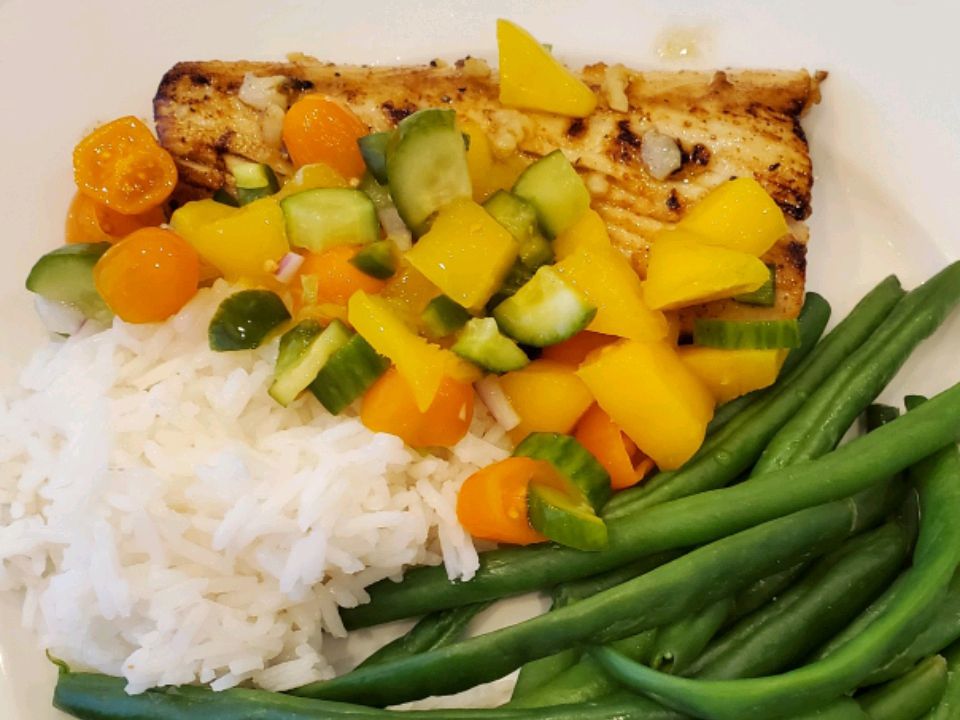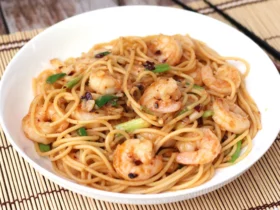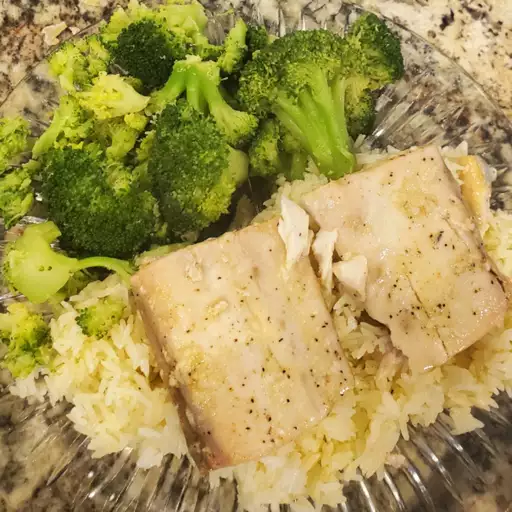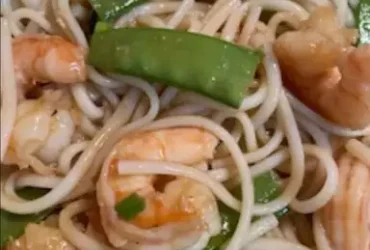Background and History
Lime-Marinated Mahi Mahi is a delightful dish that showcases the flavors of the tropics. Mahi Mahi, also known as dolphinfish, is a popular fish in Caribbean and Hawaiian cuisine, prized for its firm texture and mild flavor. Marinating the fish in lime juice not only imparts a refreshing citrus taste but also tenderizes the fish, making it succulent and flavorful. This dish is perfect for grilling, baking, or pan-searing, making it versatile for any occasion.
Serves
- 4 people
Time
- Total Time: 1 hour (including marination)
- Active Cooking Time: 20 minutes
Cooking Time
- 10-12 minutes
Ingredients
- 4 Mahi Mahi fillets
- 1/4 cup fresh lime juice (about 2-3 limes)
- 2 tablespoons olive oil
- 2 garlic cloves, minced
- 1 teaspoon ground cumin
- 1 teaspoon paprika
- 1/2 teaspoon salt
- 1/4 teaspoon black pepper
- 1/4 cup fresh cilantro, chopped (optional for garnish)
- Lime wedges (for serving)
Instructions
Prepare the Marinade
- In a bowl, combine the fresh lime juice, olive oil, minced garlic, ground cumin, paprika, salt, and black pepper. Mix well.
Marinate the Mahi Mahi
- Place the Mahi Mahi fillets in a shallow dish or a resealable plastic bag.
- Pour the marinade over the fillets, ensuring they are well-coated.
- Cover the dish or seal the bag and refrigerate for at least 30 minutes, up to 1 hour.
Cook the Mahi Mahi
Grilling: Preheat the grill to medium-high heat. Remove the fillets from the marinade and grill for 4-6 minutes per side, or until the fish is opaque and flakes easily with a fork.
Baking: Preheat the oven to 400°F (200°C). Place the marinated fillets on a baking sheet and bake for 10-12 minutes, or until the fish is cooked through.
Pan-Searing: Heat a non-stick skillet over medium-high heat. Add a small amount of oil and cook the fillets for 4-6 minutes per side, or until the fish is opaque and flakes easily with a fork.
Serve
- Transfer the cooked Mahi Mahi to serving plates.
- Garnish with fresh cilantro and lime wedges.
- Serve immediately.
Nutrition Facts (per serving)
- Calories: 220
- Protein: 25g
- Carbohydrates: 2g
- Fat: 12g
- Fiber: 0g
- Sugars: 0g
- Sodium: 300mg
Notes
- Ensure the Mahi Mahi fillets are of even thickness to cook uniformly.
- For a spicier kick, add a pinch of cayenne pepper to the marinade.
- This dish pairs well with a fresh green salad, steamed vegetables, or a side of rice.
Allergy Warning
- This dish contains fish. Ensure all ingredients and surfaces are free from cross-contamination if you have seafood allergies.
- Check all ingredient labels for any hidden allergens if you have specific dietary restrictions.
Useful and Interesting Facts
- Mahi Mahi is a low-calorie, high-protein fish rich in vitamins and minerals, making it a healthy choice for any meal.
- The acidity in lime juice helps to break down the proteins in the fish, tenderizing it and enhancing its flavor.
- This recipe is versatile and can be adapted for other types of fish such as cod, halibut, or tilapia.
FAQs about Lime-Marinated Mahi Mahi
What sides go best with mahi mahi?
Sides that go best with Mahi Mahi include fresh green salads, steamed or roasted vegetables, rice, quinoa, or a light pasta dish. Citrus-based salsas or tropical fruit salads also pair wonderfully with the mild, slightly sweet flavor of Mahi Mahi.
What is the internal temperature of mahi mahi?
The internal temperature of Mahi Mahi should reach 137°F (58°C) when fully cooked. Using a meat thermometer helps ensure that the fish is cooked to the proper temperature.
Is Peruvian mahi mahi healthy?
Yes, Peruvian Mahi Mahi is a healthy choice. It is low in calories and high in protein, vitamins, and minerals. It is also a good source of omega-3 fatty acids, which are beneficial for heart health.
How long to sous vide mahi mahi?
To sous vide Mahi Mahi, set the water bath to 130°F (54°C) and cook the fish for 30-45 minutes. This method ensures the fish is perfectly cooked and maintains its moisture and delicate texture.
Should I soak Mahi Mahi in milk before cooking?
Soaking Mahi Mahi in milk before cooking can help to neutralize any strong fishy odors and enhance its mild flavor. Soak the fillets for about 20-30 minutes before rinsing and patting them dry.
Is Mahi Mahi tough meat?
No, Mahi Mahi has a firm yet tender texture. When cooked properly, it is flaky and moist, making it an ideal fish for grilling, baking, or pan-searing.
Is undercooked Mahi Mahi safe?
Undercooked Mahi Mahi can pose a risk of foodborne illness. It is important to cook Mahi Mahi to an internal temperature of 137°F (58°C) to ensure it is safe to eat.
Can Mahi Mahi be overcooked?
Yes, Mahi Mahi can become dry and tough if overcooked. It is important to monitor the cooking time and use a meat thermometer to ensure it reaches the proper internal temperature without overcooking.
Is Mahi Mahi healthy?
Yes, Mahi Mahi is a healthy option. It is low in fat, high in protein, and rich in essential nutrients like vitamin B12, selenium, and potassium. It also contains omega-3 fatty acids, which support heart health.
How do you know when Mahi Mahi is fully cooked?
Mahi Mahi is fully cooked when it is opaque and flakes easily with a fork. You can also use a meat thermometer to check that the internal temperature has reached 137°F (58°C).
- Best LeadsGorilla Alternatives for 2025 - April 22, 2025
- Best Leadzai Alternatives for 2025 - April 22, 2025
- Best LeadSwift Alternatives for 2025 - April 21, 2025















